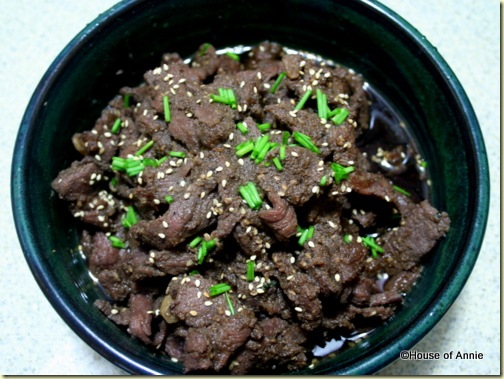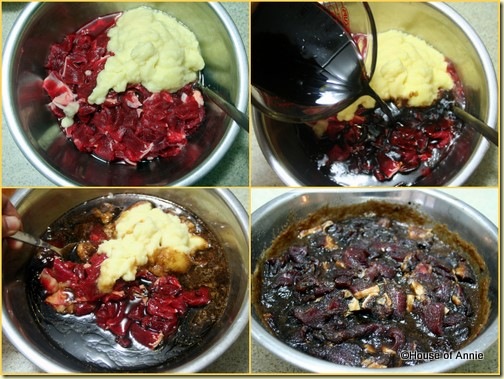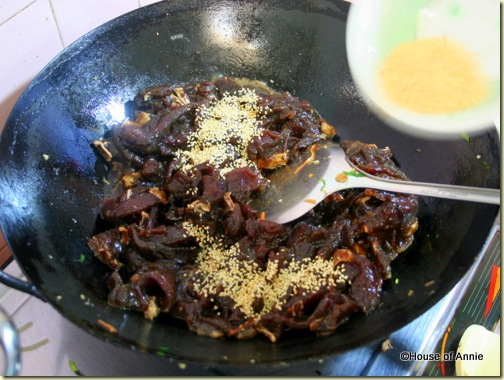When I was in San Jose, every so often, I would pop into a Korean grocery store and pick up several tubs of marinated bulgogi (uncooked) to cook at home. One tub would be used on the day it was bought and the rest would be stuck in the freezer for other times when I wanted to convenience of cooking up a quick meal.

Here in Kuching, we found that there is a small enclave of Korean expatriates around (there’s even a small Korean grocery store here) and a few Korean restaurants. So far, we’re tried two of the restaurants only to find them somewhat disappointing.
Just this past week, I had a hankering for some Korean food. So I decided to make it myself. After all, our Killer Kalbi recipe is probably one of our all-time most popular recipe (with good cause—it’s REALLY good). So I decided I needed to expand my Korean repertoire.
Kalbi Cousin
Last night, I made Bulgogi and Jap Chae (I will blog this next). And they were both really good. They complemented each other perfectly and we almost didn’t need any rice. We would have really gotten into the rice if I had some Korean seaweed (Kim) and kimchee to serve alongside the bulgogi. But I had not gotten any unfortunately. Yes, I know, it’s not complete without all these lovely sides. This will be my challenge next time (make Kimchee from scratch, not the seaweed!).
Bulgogi (to me) is a cousin to Kalbi. The marinade is very similar except that Bulgogi is a lot easier to cook and eat (no bones to deal with). It is very addictive too and I don’t know anyone who doesn’t love bulgogi when it’s served (except if you don’t eat beef). In its most basic, you stick your thinly sliced rib-eye into a marinade and cook it up. You can grill up the meat or just saute in a pan. Grilling it gives it a more smoky flavour but you lose the sauce.
I personally prefer to saute it in a pan as I can treat it almost like a stir-fry that way and you will get to save the juices from the marinate. I sometimes like to jazz it up a bit by adding some vegetables (this also makes me feel less guilty as it seems a little bit more healthy). When I add vegetables, I will normally toss in some broccoli, mushrooms, carrots, and bell peppers along with some sliced onions. This time around, I didn’t add any vegetables because I had put loads of veggies into my Jap Chae so I didn’t feel the Bulgogi needed it.
Bulgogi Marinade Recipe
for marinating 2-3 lbs of thinly sliced rib-eye beef
Ingredients
2/3 cup soy sauce (I recommend Kikkoman)
4 Tbsp honey
2 Tbsp sugar
1 Tbsp sake (rice wine)
2 Tbsp sesame oil
1 Korean pear (or a Fuji apple will also work or try a can of Coca Cola)
1 medium to large yellow onion
6 large cloves garlic
2 tsp freshly ground black pepper
garnish with: chopped green onions and toasted sesame seeds.
Method:
1. Take your pear, onion, and garlic, and chop up fine in a food processor (or grate with a box grater). Pour out into a large bowl.
2. Add to that your soy sauce, honey, sugar, sake, sesame oil, and black pepper. Mix the marinate ingredients well.
3. Place sliced beef into the marinate and mix until well coated. Cover with plastic wrap and stick beef into fridge to marinate overnight.
To cook:
4. Heat up your frying pan and add some vegetable or sesame oil (if using sesame oil, be careful to watch so it doesn’t burn). Add some chopped garlic and sliced onion (and other vegetables if you wish) and saute for a little while to just get rid of the rawness of it.
5. Add the beef (only whatever you want to eat, save the rest for another meal) and cook over med-high heat until beef is just cooked. Don’t overcook your meat guys—this is rib-eye after all! A little red left won’t hurt.
Dish out (juices and all), garnish with your chopped green onions and toasted sesame seeds, and serve over rice. For the full Korean experience, you will want some banchan (Korean sides to go along with your Bulgogi).
Bulgogi Notes
When buying meat for Bulgogi, get some rib-eye beef. You need some fat in your Bulgogi. But since you will be marinating this for a long while, don’t bother to get prime or choice grade beef. Using a lesser grade will be alright as you’re not cooking a steak, ya know?
And if your butcher is willing, get him to slice the beef thinly for you. That’ll save you some work. If your grocery doesn’t have that service, then the easiest way to slice it yourself is to freeze the beef before slicing. What I did was to take out my beef and leave it in the fridge overnight to soften it just a little, then slice. Use your sharpest knife to cut the beef as thinly as possible.
Once cut, it’s just a matter of putting together the marinade and mixing it into the sliced beef. Leave that to marinate overnight for maximum flavour. Of course, if you’re enterprising, you’d make enough for several meals, marinade and then freeze into meal-sized portions for easier cooking next time around. This recipe should give you enough to make 2-3 lbs of meat so you can very easily freeze some for another meal.
Enjoy!
Cheers, Annie
Other takes on bulgogi from: The Perfect Pantry, Use Real Butter, Burp and Slurp’s Korean-Fusion Bulgogi Gyros , Eatingclub Vancouver’s Spicy Pork Bulgogi, Single Guy Chef’s Ginger-Marinated Bulgogi-Style Chicken


Do you believe I have never tried Bulgogi? It sure does look good though!
Kalyn,
Not sure how South Beach-friendly our recipe is, but you could try using a different sweetener instead of honey and sugar.
Yes, nothing beats Korean bulgogi. It’s just SO good…..one of my top favourite Korean food. Yours looks very delicious….mmm. It’s wonderful that you meet some Korean there in Kuching. ‘Annyung haseyo’ 🙂
Looks yummy! It has been a long time since I last ate Bulgogi…no easy access to a good Korean restaurant…I guess now I can make my own. 😀 Thanks for sharing!
P.S. The Killer Kalbi looks so good too…can’t wait till it warms up and we can grill comfortably outside!
This looks really good!! I’ve been making a lot of new dishes lately and this looks like a good one to try next.
Adore Korean food! Bulgogi is always a hit 😀
This looks great! I’ve never really cooked Korean food, but I definitely love meaty dishes. Just a quick question: You mentioned the banchan (the Korean sides). What sides do you normally eat with this dish?
Edmund –
kim chee, of course 😉
But also bean sprouts, seaweed, spinach…
I made this alongside Jap Chae and liked it. I don’t have a blender or food processor, so I minced the pear, onion, and garlic very finely instead. I put in some sliced onion and chopped garlic while cooking, too, but I think I’ll leave those out next time as the flavor was a bit overpowering. I garnished with lots of green onion, yum.
My main complaint might just be in my head: I had recently fixed your recipe for niku-jaga, where you cautioned not to re-use the onions that marinated the beef because they will “taste like rust.” This seemed to be a similar situation. I didn’t cook up all the bulgogi marinade, only the bits that clung to the beef, but that was most of it. And it tasted like rust. 🙁
Next time I will puree the marinade in a real food processor and try not to think about rust, and we’ll see if it helps. This time around, three stars because of the unnecessary extra onions and garlic and mostly because of the rust.
This is one of my favorite recipes!! I have been using this recipe for 4 years now. When i was in college i would make huge amounts to save me for the month. Thank you for sharing this recipe 🙂
Brandon,
thanks for the comment! Glad you liked the recipe.